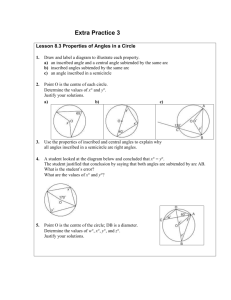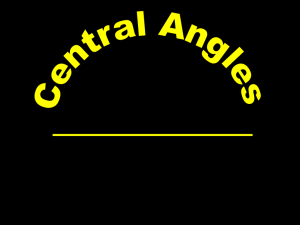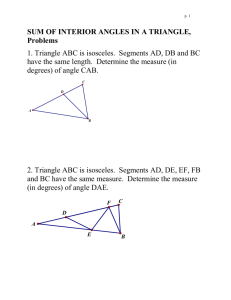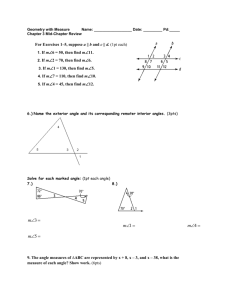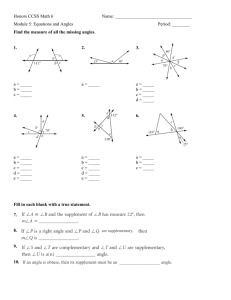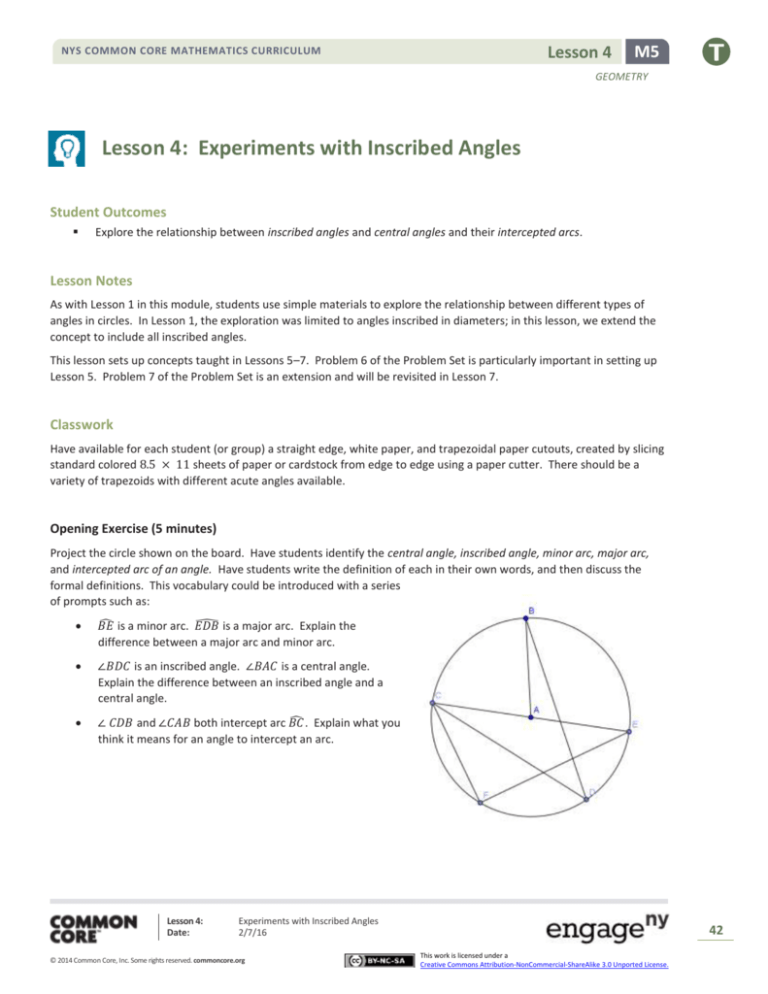
Lesson 4
NYS COMMON CORE MATHEMATICS CURRICULUM
M5
GEOMETRY
Lesson 4: Experiments with Inscribed Angles
Student Outcomes
Explore the relationship between inscribed angles and central angles and their intercepted arcs.
Lesson Notes
As with Lesson 1 in this module, students use simple materials to explore the relationship between different types of
angles in circles. In Lesson 1, the exploration was limited to angles inscribed in diameters; in this lesson, we extend the
concept to include all inscribed angles.
This lesson sets up concepts taught in Lessons 5–7. Problem 6 of the Problem Set is particularly important in setting up
Lesson 5. Problem 7 of the Problem Set is an extension and will be revisited in Lesson 7.
Classwork
Have available for each student (or group) a straight edge, white paper, and trapezoidal paper cutouts, created by slicing
standard colored 8.5 × 11 sheets of paper or cardstock from edge to edge using a paper cutter. There should be a
variety of trapezoids with different acute angles available.
Opening Exercise (5 minutes)
Project the circle shown on the board. Have students identify the central angle, inscribed angle, minor arc, major arc,
and intercepted arc of an angle. Have students write the definition of each in their own words, and then discuss the
formal definitions. This vocabulary could be introduced with a series
of prompts such as:
̂ is a minor arc. 𝐸𝐷𝐵
̂ is a major arc. Explain the
𝐵𝐸
difference between a major arc and minor arc.
∠𝐵𝐷𝐶 is an inscribed angle. ∠𝐵𝐴𝐶 is a central angle.
Explain the difference between an inscribed angle and a
central angle.
̂ . Explain what you
∠ 𝐶𝐷𝐵 and ∠𝐶𝐴𝐵 both intercept arc 𝐵𝐶
think it means for an angle to intercept an arc.
Lesson 4:
Date:
Experiments with Inscribed Angles
2/7/16
© 2014 Common Core, Inc. Some rights reserved. commoncore.org
42
This work is licensed under a
Creative Commons Attribution-NonCommercial-ShareAlike 3.0 Unported License.
Lesson 4
NYS COMMON CORE MATHEMATICS CURRICULUM
M5
GEOMETRY
Opening Exercise
ARC: An arc is a portion of the circumference of a circle.
MINOR AND MAJOR ARC: Let 𝑪 be a circle with center 𝑶, and let 𝑨 and 𝑩 be different points that lie on 𝑪 but are not the
endpoints of the same diameter. The minor arc is the set containing 𝑨, 𝑩, and all points of 𝑪 that are in the interior of
∠𝑨𝑶𝑩. The major arc is the set containing 𝑨, 𝑩, and all points of 𝑪 that lie in the exterior of ∠𝑨𝑶𝑩. Examples: Minor
̂ . Answers will vary.
̂ , 𝑬𝑫
̂ . Major Arc 𝑬𝑫𝑩
̂ , 𝑫𝑪𝑬
Arc 𝑩𝑬
INSCRIBED ANGLE: An inscribed angle is an angle whose vertex is on a circle and each side of the angle intersects the circle in
another point. Examples: ∠𝑩𝑫𝑪, ∠𝑬𝑪𝑫. Answers will vary.
CENTRAL ANGLE: A central angle of a circle is an angle whose vertex is the center of a circle. Examples: ∠𝑪𝑨𝑩, ∠𝑩𝑨𝑬.
Answers will vary.
INTERCEPTED ARC OF AN ANGLE. An angle intercepts an arc if the endpoints of the arc lie on the angle, all other points of the
̂.
̂ , 𝑪𝑭
arc are in the interior of the angle, and each side of the angle contains an endpoint of the arc. Examples: 𝑬𝑫
Answers will vary.
Exploratory Challenge 1 (10 minutes)
Exploratory Challenge 1
Your teacher will provide you with a straight edge, a sheet of colored paper in the shape of a
trapezoid, and a sheet of plain white paper.
Draw 𝟐 points no more than 𝟑 inches apart in the middle of the plain white paper, and
label them 𝑨 and 𝑩.
Use the acute angle of your colored trapezoid to plot a point on the white sheet by
placing the colored cutout so that the points 𝑨 and 𝑩 are on the edges of the acute
angle and then plotting the position of the vertex of the angle. Label that vertex 𝑪.
Repeat several times. Name the points 𝑫, 𝑬, ….
The students’ task is as appears below:
Scaffolding:
If students are struggling
with acute and obtuse
angles of a trapezoid being
supplementary, have them
confirm by folding or
tearing the trapezoid into
segments containing the
angles and putting them
together as they did in
Grade 5, Module 6.
Display the definition of
supplementary angles.
D
C
A
Lesson 4:
Date:
B
Experiments with Inscribed Angles
2/7/16
© 2014 Common Core, Inc. Some rights reserved. commoncore.org
43
This work is licensed under a
Creative Commons Attribution-NonCommercial-ShareAlike 3.0 Unported License.
Lesson 4
NYS COMMON CORE MATHEMATICS CURRICULUM
M5
GEOMETRY
As students receive their materials, ask them to label the acute angle of the trapezoid. What is the
relationship between the acute angle and the obtuse angle?
They are supplementary.
As students complete the point-plotting, ask, “What shape do the plotted points form?”
MP.3
&
MP.7
The points seem to be the major arc of a circle.
How can you find the minor arc of the circle? Explain how you know.
We can find the minor arc of the circle by pushing the supplementary angle of the trapezoid through
the two original points from above. If the acute angle creates a major arc, the supplementary angle
would produce a smaller (minor) arc.
How does this relate to the work we did on Thales’ theorem in Lesson 1?
In Lesson 1, we showed that a triangle created by connecting the endpoints of a diameter with any
other point on a circle is a right triangle. We used a right angle (a corner of a plain piece of paper) to
create our original semicircle. Here, we are using the acute and obtuse angles of a trapezoid to create
major and minor arcs of a circle.
Exploratory Challenge 2 (10 minutes)
Have students further explore the angles formed by connecting points 𝐴 and 𝐵 in their drawing with any one of the
points they marked at the vertex (𝐶, 𝐷, 𝐸…) as it was moved through points 𝐴 and 𝐵.
When you trace over the angles formed by points 𝐴 and 𝐵 and the vertex point (𝐶, 𝐷, 𝐸…) you marked, what
do you notice about the measures of the angles you drew?
All angles drawn with a vertex on the major arc have the same measure – the measure of the acute
angle of the trapezoid.
What happens when you trace over the angles formed by points 𝐴 and 𝐵 and the vertex of the obtuse angle?
All angles drawn with a vertex on the minor arc have the same measure – the measure of the obtuse
angle of the trapezoid.
Eexploratory Challenge 2
a.
Draw several of the angles formed by connecting points 𝑨 and 𝑩 on your paper with any of the additional
points you marked as the acute angle was “pushed” through the points (𝑪, 𝑫, 𝑬,…). What do you notice
about the measures of these angles?
All angles have the same measure – the measure of the acute angle on the trapezoid.
MP.8
b.
Draw several of the angles formed by connecting points 𝑨 and 𝑩 on your paper with any of the additional
points you marked as the obtuse angle was “pushed” through the points from above. What do you notice
about the measures of these angles?
All angles have the same measure – the measure of the obtuse angle on the trapezoid.
Lesson 4:
Date:
Experiments with Inscribed Angles
2/7/16
© 2014 Common Core, Inc. Some rights reserved. commoncore.org
44
This work is licensed under a
Creative Commons Attribution-NonCommercial-ShareAlike 3.0 Unported License.
Lesson 4
NYS COMMON CORE MATHEMATICS CURRICULUM
M5
GEOMETRY
Exploratory Challenge 3 (10 minutes)
Continue the exploration, providing each student with several copies of the circle at the end of the lesson, a
straightedge, and scissors. They will select a point on the circle and create an inscribed angle. Each student will cut out
his or her angle and compare it to the angle of several neighbors. All students started with the same arc thus, all
inscribed angles will have the same measure. This can also be confirmed using protractors to measure the angles
instead of cutting the angles out or modeled by the teacher.
Exploratory Challenge 3
a.
Draw a point on the circle, and label it 𝑫. Create angle ∠𝑩𝑫𝑪.
b.
∠𝑩𝑫𝑪 is called an inscribed angle. Can you explain why?
The vertex is on the circle, and the sides of the angle pass through points that are also on the circle.
c.
̂ is called the intercepted arc. Can you explain why?
Arc 𝑩𝑪
It is the arc cut in the circle by the inscribed angle.
d.
Carefully cut out the inscribed angle, and compare it to the angles of several of your neighbors.
e.
What appears to be true about each of the angles you drew?
All appear to have the same measure.
f.
Draw another point on a second circle, and label it point 𝑬. Create angle ∠𝑩𝑬𝑪, and cut it out. Compare
∠𝑩𝑫𝑪 and ∠𝑩𝑬𝑪. What appears to be true about the two angles?
All appear to have the same measure.
g.
What conclusion may be drawn from this? Will all angles inscribed in the circle from these two points have
the same measure?
All angles inscribed in the circle from these two points will have the same measure.
h.
Explain to your neighbor what you have just discovered.
Lesson 4:
Date:
Experiments with Inscribed Angles
2/7/16
© 2014 Common Core, Inc. Some rights reserved. commoncore.org
45
This work is licensed under a
Creative Commons Attribution-NonCommercial-ShareAlike 3.0 Unported License.
Lesson 4
NYS COMMON CORE MATHEMATICS CURRICULUM
M5
GEOMETRY
Exploratory Challenge 4 (3 minutes)
Extend the exploration, using the circle given, select two points on the circle (B and C), and use those two points as
endpoints of an intercepted arc for a central angle.
Exploratory Challenge 4
a.
In the circle below, draw the angle formed by connecting points 𝑩 and 𝑪 to the center of the circle.
b.
Is ∠𝑩𝑨𝑪 an inscribed angle? Explain.
No. The vertex is not on the circle; the vertex is the center of the circle.
c.
Is it appropriate to call this the central angle? Why or why not?
The acute angle (∠𝑩𝑨𝑪) is formed by connecting points 𝑩 and 𝑪 to the center point (𝑨), so it would be
appropriate to call this a central angle.
d.
What is the intercepted arc?
̂.
The intercepted arc is 𝑩𝑪
e.
Is the measure of ∠𝐁𝐀𝐂 the same as the measure of one of the inscribed angles in Example 2?
No, the measure of ∠𝑩𝑨𝑪 is greater.
f.
Can you make a prediction about the relationship between the inscribed angle and the central angle?
The inscribed angle is about half the central angle. The central angle is double the inscribed angle.
Closing (2 minutes)
Have students explain to a partner the answer to the prompt below, and then call the class together to review the
Lesson Summary.
What is the difference between an inscribed angle and a central angle?
Lesson 4:
Date:
Experiments with Inscribed Angles
2/7/16
© 2014 Common Core, Inc. Some rights reserved. commoncore.org
46
This work is licensed under a
Creative Commons Attribution-NonCommercial-ShareAlike 3.0 Unported License.
Lesson 4
NYS COMMON CORE MATHEMATICS CURRICULUM
M5
GEOMETRY
Lesson Summary
All inscribed angles from the same intercepted arc have the same measure.
Relevant Vocabulary
ARC: An arc is a portion of the circumference of a circle.
MINOR AND MAJOR ARC: Let 𝑪 be a circle with center 𝑶, and let 𝑨 and 𝑩 be different points
that lie on 𝑪 but are not the endpoints of the same diameter. The minor arc is the set
containing 𝑨, 𝑩, and all points of 𝑪 that are in the interior of ∠𝑨𝑶𝑩. The major arc is the
set containing 𝑨, 𝑩, and all points of 𝑪 that lie in the exterior of ∠𝑨𝑶𝑩.
INSCRIBED ANGLE: An inscribed angle is an angle whose vertex is on a circle, and each side of
the angle intersects the circle in another point.
CENTRAL ANGLE: A central angle of a circle is an angle whose vertex is the center of a circle.
INTERCEPTED ARC OF AN ANGLE: An angle intercepts an arc if the endpoints of the arc lie on the
angle, all other points of the arc are in the interior of the angle, and each side of the angle
contains an endpoint of the arc.
Exit Ticket (5 minutes)
Lesson 4:
Date:
Experiments with Inscribed Angles
2/7/16
© 2014 Common Core, Inc. Some rights reserved. commoncore.org
47
This work is licensed under a
Creative Commons Attribution-NonCommercial-ShareAlike 3.0 Unported License.
Lesson 4
NYS COMMON CORE MATHEMATICS CURRICULUM
M5
GEOMETRY
Name
Date
Lesson 4: Experiments with Inscribed Angles
Exit Ticket
Joey marks two points on a piece of paper, as we did in the Exploratory Challenge, and labels them 𝐴 and 𝐵. Using the
trapezoid shown below, he pushes the acute angle through points 𝐴 and 𝐵 from below several times so that the sides of
the angle touch points 𝐴 and 𝐵, marking the location of the vertex each time. Joey claims that the shape he forms by
doing this is the minor arc of a circle and that he can form the major arc by pushing the obtuse angle through points 𝐴
and 𝐵 from above. “The obtuse angle has the greater measure, so it will form the greater arc,” states Joey.
Ebony disagrees, saying that Joey has it backwards. “The acute angle will trace the major arc,” claims Ebony.
C
D
C
A
B
1.
Who is correct, Joey or Ebony? Why?
2.
How are the acute and obtuse angles of the trapezoid related?
3.
If Joey pushes one of the right angles through the two points, what type of figure is created? How does this relate
to the major and minor arcs created above?
Lesson 4:
Date:
Experiments with Inscribed Angles
2/7/16
© 2014 Common Core, Inc. Some rights reserved. commoncore.org
48
This work is licensed under a
Creative Commons Attribution-NonCommercial-ShareAlike 3.0 Unported License.
Lesson 4
NYS COMMON CORE MATHEMATICS CURRICULUM
M5
GEOMETRY
Exit Ticket Sample Solutions
Joey marks two points on a piece of paper, as we did in the Exploratory Challenge, and labels them 𝑨 and 𝑩. Using the
trapezoid shown below, he pushes the acute angle through points 𝑨 and 𝑩 from below several times so that the sides of
the angle touch points 𝑨 and 𝑩, marking the location of the vertex each time. Joey claims that the shape he forms by
doing this is the minor arc of a circle and that he can form the major arc by pushing the obtuse angle through points 𝑨 and
𝑩 from above. “The obtuse angle has the greater measure, so it will form the greater arc,” states Joey.
Ebony disagrees, saying that Joey has it backwards. “The acute angle will trace the major arc,” claims Ebony.
C
C
A
1.
D
B
Who is correct, Joey or Ebony? Why?
Ebony is correct. The acute angle vertex traces out the major arc of the circle.
2.
How are the acute and obtuse angles of the trapezoid related?
They are supplementary.
3.
If Joey pushes one of the right angles through the two points, what type of figure is created? How does this relate
to the major and minor arcs created above?
A semicircle is created. Both arcs will be the same measure (𝟏𝟖𝟎°).
Problem Set Sample Solutions
1.
Using a protractor, measure both the inscribed angle and the central angle shown on the circle below.
𝒎∠𝑩𝑪𝑫 = __________
𝒎∠𝑩𝑨𝑫 = __________
𝟗𝟎°; 𝟏𝟖𝟎°
Lesson 4:
Date:
Experiments with Inscribed Angles
2/7/16
© 2014 Common Core, Inc. Some rights reserved. commoncore.org
49
This work is licensed under a
Creative Commons Attribution-NonCommercial-ShareAlike 3.0 Unported License.
Lesson 4
NYS COMMON CORE MATHEMATICS CURRICULUM
M5
GEOMETRY
2.
Using a protractor, measure both the inscribed angle and the central angle shown on the circle below.
𝒎∠𝑩𝑫𝑪 = __________
𝒎∠𝑩𝑨𝑪 = __________
𝟑𝟎°; 𝟔𝟎°
3.
Using a protractor, measure both the inscribed angle and the central angle shown on the circle below.
𝒎∠𝑩𝑫𝑪 = __________
𝒎∠𝑩𝑨𝑪 = __________
𝟓𝟎°; 𝟏𝟎𝟎°
4.
What relationship between the measure of the inscribed angle and the measure of the central angle that intercept
the same arc is illustrated by these examples?
The measure of the inscribed angle appears to be half the measure of the central angle that intercepts the same arc.
5.
Is your conjecture at least true for inscribed angles that measure 𝟗𝟎°?
̅̅̅̅ is a diameter of the circle, then
Yes, according to Thales’ theorem, if 𝑨, 𝑩, and 𝑪 are points on a circle where 𝑨𝑪
∠𝑨𝑩𝑪 is a right angle. Since a diameter represents an 𝟏𝟖𝟎° angle, our conjecture is always true for angles that
measure 𝟗𝟎°.
Lesson 4:
Date:
Experiments with Inscribed Angles
2/7/16
© 2014 Common Core, Inc. Some rights reserved. commoncore.org
50
This work is licensed under a
Creative Commons Attribution-NonCommercial-ShareAlike 3.0 Unported License.
Lesson 4
NYS COMMON CORE MATHEMATICS CURRICULUM
M5
GEOMETRY
6.
Prove that 𝒚 = 𝟐𝒙 in the diagram below.
△ 𝑨𝑩𝑪 is an isosceles triangle since all radii of a circle are congruent. Therefore, 𝒎∠𝑩 = 𝒎∠𝑪 = 𝒙. In addition,
𝒚 = 𝒎∠𝑩 + 𝒎∠𝑪 since the measure of an exterior angle of a triangle is equal to the sum of the measures of the
opposite interior angles. By substitution, 𝒚 = 𝒙 + 𝒙, or 𝒚 = 𝟐𝒙.
7.
Red (𝑹) and blue (𝑩) lighthouses are located on the coast of the ocean. Ships traveling are in safe waters as long as
the angle from the ship (𝑺) to the two lighthouses (∠𝑹𝑺𝑩) is always less than or equal to some angle 𝜽 called the
“danger angle.” What happens to 𝜽 as the ship gets closer to shore and moves away from shore? Why do you think
a larger angle is dangerous?
The closer the boat is to the shore, the larger 𝜽 will be, and as the boat moves away from shore, 𝜽 gets smaller. 𝑨
smaller 𝜽 means the ship is in deeper water, which is safer for ships.
Red (𝑹)
Blue (𝑩)
Lesson 4:
Date:
Experiments with Inscribed Angles
2/7/16
© 2014 Common Core, Inc. Some rights reserved. commoncore.org
51
This work is licensed under a
Creative Commons Attribution-NonCommercial-ShareAlike 3.0 Unported License.
NYS COMMON CORE MATHEMATICS CURRICULUM
Lesson 4
M5
GEOMETRY
Example 2
Lesson 4:
Date:
Experiments with Inscribed Angles
2/7/16
© 2014 Common Core, Inc. Some rights reserved. commoncore.org
52
This work is licensed under a
Creative Commons Attribution-NonCommercial-ShareAlike 3.0 Unported License.


